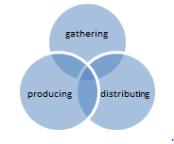CBC, Ambient Journalism?
On 1st Oct, 2013, we( MAs in communication program of University of Ottawa in a course called “New direction of journalism”) went on a trip to CBC, which “is a Canadian crown corporation that serves as the national public radio and television broadcaster(Wikipedia)”[1] ,to get some basic knowledge of journalistic working environment, production system and daily agenda. And as the title illustrates, this experience to CBC will be taken as a supportive example to discuss “whether the ‘ambient journalism’ is enthusiastically embraced by the mainstream journalism” in this blog.
The reading materials in the week three have mentioned the connection of 3 main elements: democracy, social media, and journalism. Natalie Fenton points out that innovative news-webs being established by citizens could never replace newsrooms that enjoy real freedom from both government and commercial-intended market, and other authors focus on how journalism and social networks are influencing each other.
It is easy to notice that the relationship between the social media and journalism has been especially analyzed and discussed. Knowing from these articles, a new pattern of journalism—ambient journalism, where “people contribute to the creation, dissemination and discussion of news via social media services such as Twitter (Hermida 2012, p.5) ”, or as Hermida says in the reading of week three “where the journalism itself becomes fragmented and omnipresent, constructed by both journalists and audiences”[2] , Hermida, A. (2012)—is on its way.
By using UGC, blogs, message boards, sharing of recommendations and social network functionality and so on, mainstream media are aiming to tell better stories, make a better relationship with the audience and get more users. However, problems related to verification, objectivity, professional identity, public privacy issue, accountability and transparency of journalism are occurring in the process. How, exactly, do mainstream journalism like CBC cope with such an issue? Fortunately, it could be answered partially, though not thoroughly, with the information gathered during the CBC trip and from the CBC website news.
News Gathering
As Alfred Hermida says in the article assigned, “tweeter effect” is termed by Bruno in 2011 to describe “how online tools that facilitate the publication and distribution of user-generated, real-time content are affecting how the news is reported and by whom”[3],Hermida, A. (2012). Thus, with a great number of people reporting news and their referrals, the way in which the news are gathered by mainstream journalism has been transformed. And apart from Tweeter, social media like Facebook and search engine like Google are also playing a crucial role in this transformation.
To be specific, by attending and observing the their morning meeting( including managers, reporters, journalists, editors ,producers, etc.), it is not difficult to notice that there are diverse sources of news are now being used: newspapers reports, news reported by other TV stations, Google recommended news, personal experience, and social media such as Facebook feeds and tweets are newcomers. Only one person brought newspapers there, and about one-fourth of the meeting time was used to discover Facebook feeds which they thought may be of value and could appeal to an audience, but doubts as “but, you know, it may not be true” are always followed, which are mentioned either seriously or playfully. For example, there was a Facebook feed referred thousands of times calling on people to find a girl who had disappeared and cannot be contacted for as long as one week, the reality of this piece of news had been doubted right after it was retold by someone in this meeting.
|
As to Twitter and Facebook, they are described as “the ‘kings’ in the realm of social media in the newsrooms” by Garcí a de Torres et al. (2011) in their analysis of 27 Iberian and South American news outlets. And it is clearly illustrated in this bar chart that the journalists are taking the advantage of social media more by viewing it as a source of newsgathering rather than depending on the so-called “crowdsourcing” and thus, the path of the ideal “pro-am journalism” is rough—the participation of the citizens and the interaction and co-creation between the professional journalists and amateurs is not as positive as the public desires.
Verification—Priority
-Double Check
To make sure whether to report the feeds on social media like Facebook or not, they decided to write them down first and then go and “double-check” it to confirm their certainty. And this seems to be the main responsibility and a priority in the CBC news production. “New information needs to be corroborated by a second source…We are constantly evolving our journalistic standards and practices and have mandated our new director of journalistic accountability to propose changes that would address these issues. Our reputation depends on it”[5], said by Jennifer McGuire, the general manager and editor in chief of CBC, when writing about the importance of their journalistic verification on her blog.
In one of her blogs—Covering the Ottawa Train-Bus Crash, she confirmed this point of view again when talking about the release of the bus driver’s name: “By 11 am, we learned from a reliable source the full name of the bus driver…We then double confirmed this, with two other reliable sources…in the sensitive case of a death, we almost always hold back”[6].
-Accuracy > Speed
With the advent of social media and its flourish, what Jennifer McGuire has in mind is coherent with Newman’s opinion: “news organizations are already abandoning attempts to be first for breaking news, focusing instead on being the best at verifying and curating it.” [7]Rather than racing with the pace of the development of the social reports, mainstream journalism (CBC in this blog) is switching their role(not totally) into a curator of news production to navigate, sift and check the vast amounts of data on social media streams while producing its own news in traditional way. Thus, the nature of breaking news is being changed. A journalist of CBC emphasized this concept during our trip there and said that it is the accuracy of the news which could give rise to their authority that keeps CBC different from or even superior to the other media. This could be seen from a story discussed on their morning meeting as well: Journalists there have been zooming and verifying the accuracy of a certain case for weeks instead of concentrating on how fast it could be reported to the public.
Also there is a report published by Ryerson University–How journalists retrospectively describe processes for ensuring accuracy[8],Ivor Shapiro, Colette Brin, Isabelle Bédard-Brûlé & Kasia Mychajlowycz(2013)—in which 28 newspapers in Canada have been studied and it is worth noting that all of them are continuing to make verification of facts a priority, which is a very amazing result and could serve well as this subtitle as print journalism is heading in the same direction with TV stations such as CBC while the social media journalism is booming.
New Reporting
Not only by broadcasting or writing print reports, journalists are now also able to report on blogs and microblogs, which is more popular than the former right now. And CBC is linking the content of the tweets of their journalists to their online news page now (Pic1).

|
Pic 1: Alberta school bus crash leaves boy, 5, in critical condition, Oct 25, 2013, 11:39 AM MT,
|
This is an article reporting an Alberta school bus crash happened on 25th, Oct 2013. We could see from the first screenshot that before writing this news article, the journalist Jen Lee kept tweeting about the ongoing situation of the school bus crash which came into a real-time/ live journalistic reporting(Live coverage). And some tweets of other CBC journalists covering this accident were shown a day after( as the second screenshot shows). The live microblogs function well in being the first( though not that urgent—the content of the tweets turn out to be more than verified to some extent, though may not the as reliable as the formal ones) , nonetheless, such tweets shown on the news pages among most coverages of CBC website are mostly reported by their own or appointed journalists or correspondents rather than a combination between unverified citizen tweets and authenticated professional reports. Fortunately, it is gratifying to find that, some citizen witness is included and reported as a part of the coverage on the second day, as is shown in the following screenshot. Therefore, what could be summed up is that CBC is continuing its traditional reporting pattern in the digital age, though with some slight evidence to involve the citizens in the news report. Maybe it is trying to form the pro-am journalism, but, I would rather say, with a conservative effort.
Additionally, when covering the train-bus crash in Ottawa, CBC used its own organizational norms and ethics—picking up pictures uploaded by citizens with Twitter in terms of their own value, rewrote citizens’ content of tweets instead of quoting( did not find any related quotes in any coverage of this crisis), and when questioned by audience through Twitter that CBC “has overstepped the bounds of decency by airing a conversation with Ms. Woodard the day after her husband had died”, the CBC ignored it and continued the coverage and even called for the understanding of the audience instead of apologise or detailed explanations by saying “while we appreciate and respect the many differing comments and opinions we invite from our audiences, we also feel it’s important to help people understand why and how we made some of the decisions we did.”—which indicates, as Hermida says, “a relatively closed professional culture for the production of knowledge, based on a system of editorial control”—“ Journalists are beginning to embrace social media tools like Twitter, Blogs, and Facebook, but very much on their own terms[9]”.
Conclusion
At present, journalists in the mainstream media, CBC particularly in this blog, is having more access to diverse news sources with the appearance and development of the social media. However, it cannot be ignored that coming with the diversity are more and more false or faked reports, videos, images, etc. Therefore, while being a producer, CBC is also acting as a curator to keep an eye on news reported on social media, then selected and reproduced to make sure of the accuracy of the reports which is seen as the priority of current journalism by double or even triple checking them. Besides, instead of using the citizen reports directly, professional journalists prefer to re-report the issues in their own term which is not accorded with the ideal characteristics of current journalism—positively interactive and participative.
In short, “ Journalists are normalizing social media rather than adapting their occupational culture” to what Lasorsa, Lewis, and Holton describe as “a new media format that directly challenges them”.
[2] Hermida, A. (2012). “Chapter 17: Social Journalism: Exploring how Social Media is Shaping Journalism”. In The Handbook of Global Online Journalism. Eds. Eugenia Siapera & Andreas Veglis. Wilely. Pp.
[3] Newman, Nic. (2009). “Rise of social media and its impact on mainstream journalism:” Reuters Institute for the Study of Journalism: Oxford.
[4] http://hujo.deri.ie/skeptics-conformists-and-activists-how-and-why-journalists-use-social-media/
[5] http://www.cbc.ca/newsblogs/community/editorsblog/2013/05/verification-why-getting-it-right-trumps-getting-it-first.html
[6] http://www.cbc.ca/newsblogs/community/editorsblog/2013/09/covering-the-ottawa-train-bus-crash.html
[7] Newman, Nic. (2009). “Rise of social media and its impact on mainstream journalism:” Reuters Institute for the Study of Journalism: Oxford.
[8] Verification as a Strategic Ritual—How journalists retrospectively describe processes for ensuring accuracy, Ivor Shapiro, Colette Brin, Isabelle Bédard-Brûlé & Kasia Mychajlowycz, pages 657-673, Published online: 05 Feb 2013











